Low-Power Energy-Efficient Hetero-Dielectric Gate-All-Around MOSFETs: Enablers for Sustainable Smart City Technology
Abstract
1. Introduction
2. Device Structure and Simulation Methodology
Device Physics
- The Drift-Diffusion Model (DDML) is used to create a sequence of Poisson equations. It is strong and works instantly for the created structures.
- The ‘φ’ symbol represents the electron charge, the ‘q’ symbol indicates the electrostatic charge of the vacuum level and and represent the doping ionized proportion. The number of holes is denoted by ‘p’ and the number of electrons is indicated by ‘n’.
- Monitoring the carrier’s motion in the device’s inverted layer serves as a role model for Lombardi’s mobility. The combined mobility of doped carriers is outlined below:
- Kane’s model for band-to-band tunneling-based carrier generation is represented in Equation (3).
- The aforementioned process for the Shockley Read Hall (SRH) recombination with carriers examines the mutation rate and is shown below:
3. Inverters Design Structure and Simulation
4. Results and Discussion
4.1. Device: Analysis of Electrical Characteristics and SCEs
4.2. Device: Analysis of Analog Parameters
4.3. Comparative Analysis of Proposed Devices with the Existing Literature
4.4. Optimized Inverters
Transient Analysis and Noise Margin of Inverters
- Noise Margin: The noise margin determines the noise immunity of circuits, and this is indicated by NM [29]. The circuit with a higher value of NM shows high noise sensitivity. The expression for calculating NM for low signals (NML) and for high signals (NMH) is expressed as follows:
4.5. Comparison of Designed Optimized Inverters with Previous Work
5. Conclusions
Author Contributions
Funding
Data Availability Statement
Acknowledgments
Conflicts of Interest
References
- Wang, R.; Jørgensen, A.B.; Dalal, D.N.; Luan, S.; Zhao, H.; Munk-Nielsen, S. Integrating 10-kV SiC MOSFET into battery energy storage system with a scalable converter-based self-powered gate driver. IEEE J. Emerg. Sel. Top. Power Electron. 2022, 11, 351–360. [Google Scholar] [CrossRef]
- Bhol, K.; Jena, B.; Nanda, U. Silicon nanowire GAA-MOSFET: A workhorse in nanotechnology for future semiconductor devices. Silicon 2022, 14, 3163–3171. [Google Scholar] [CrossRef]
- Duan, H. From MOSFET to FinFET to GAAFET: The evolution, challenges, and future prospects. Appl. Comput. Eng. 2024, 50, 113–120. [Google Scholar] [CrossRef]
- Jena, B.; Bhol, K.; Nanda, U. Exploration of Linearity Analysis in Nanotube GAA MOSFET Through Simulation-Based Study Utilizing Multi-Material Gate Technique. Trans. Electr. Electron. Mater. 2024, 25, 470–478. [Google Scholar] [CrossRef]
- Singh, A.P.; Kumar, A.; Chaudhary, B.S.; Tiwari, G.; Baghel, R.K.; Tirkey, S. Recessed-Source/Drain Junctionless GAA MOSFETs and their Sensitivity to Temperature: A Machine learning based Analysis. In Proceedings of the 2023 International Conference on Next Generation Electronics (NEleX), Vellore, Tamil Nadu, India, 14–16 December 2023; IEEE: New York, NY, USA, 2023; pp. 1–6. [Google Scholar]
- Kumar, C.M.; Mohan, Y.; Vimala, P. A study of gaa silicon nanowire mosfets for better performance. In Proceedings of the 2023 IEEE International Conference on Electronics, Computing and Communication Technologies (CONECCT), Nanning, China, 21–23 July 2023; IEEE: New York, NY, USA, 2023; pp. 1–4. [Google Scholar]
- Kumar, A.S.; Deekshana, M.; Sreenivasulu, V.B.; Kumari, N.A.; Shanthi, G. Device analysis of vertically stacked GAA nanosheet fet at advanced technology node. In Proceedings of the 2023 3rd International Conference on Advances in Computing, Communication, Embedded and Secure Systems (ACCESS), Ernakulam, India, 18–20 May 2023; IEEE: New York, NY, USA, 2023; pp. 274–279. [Google Scholar]
- Nagy, D.; Indalecio, G.; Garcia-Loureiro, A.J.; Elmessary, M.A.; Kalna, K.; Seoane, N. FinFET versus gate-all-around nanowire FET: Performance, scaling, and variability. IEEE J. Electron. Devices Soc. 2018, 6, 332–340. [Google Scholar] [CrossRef]
- Yadav, R.; Ahuja, K.; Rathee, D.S. Performance enhancement of GAA multi-gate nanowire with asymmetric hetero-dielectric oxide. Silicon 2022, 14, 1935–1946. [Google Scholar] [CrossRef]
- Lee, Y.; Park, G.-H.; Choi, B.; Yoon, J.; Kim, H.-J.; Kim, D.H.; Kim, D.M.; Kang, M.-H.; Choi, S.-J. Design study of the gate-all-around silicon nanosheet MOSFETs. Semicond. Sci. Technol. 2020, 35, 03LT01. [Google Scholar] [CrossRef]
- Kumar, M.; Haldar, S.; Gupta, M.; Gupta, R.S. Impact of gate material engineering (GME) on analog/RF performance of nanowire Schottky-barrier gate all around (GAA) MOSFET for low power wireless applications: 3D T-CAD simulation. Microelectron. J. 2014, 45, 1508–1514. [Google Scholar] [CrossRef]
- Veshala, M.; Jatooth, R.; Reddy, K.R. Reduction of short-channel effects in FinFET. Int. J. Eng. Innov. Technol. (IJEIT) 2013, 2, 118–124. [Google Scholar]
- Madan, J.; Gupta, R.S.; Chaujar, R. Performance investigation of heterogeneous gate dielectric-gate metal engineered–gate all around-tunnel FET for RF applications. Microsyst. Technol. 2017, 23, 4081–4090. [Google Scholar] [CrossRef]
- Semiconductor Digest News and Industry Trends. IBM Announces 2 nm GAA FET Technology. Available online: https://www.semiconductor-digest.com/ibm-announces-2nm-gaa-fet-technology-the-sum-of-aha-moments/ (accessed on 16 January 2025).
- Mukesh, S.; Zhang, J. A review of the gate-all-around nanosheet FET process opportunities. Electronics 2022, 11, 3589. [Google Scholar] [CrossRef]
- Rewari, S.; Nath, V.; Haldar, S.; Deswal, S.S.; Gupta, R.S. Gate-induced drain leakage reduction in the cylindrical dual-metal hetero-dielectric gate all around MOSFET. IEEE Trans. Electron. Devices 2017, 65, 3–10. [Google Scholar] [CrossRef]
- Ghosh, S.; Pachal, P.; Kumar, R.; Kundu, S.; Ghosh, J.; Sarkar, S.K. Double gate pnpn TFET with hetero oxide dielectric and high-k spacer engineering. In Proceedings of the 2020 IEEE Vlsi Device Circuit and System (Vlsi Dcs), Kolkata, India, 18–19 July 2020; IEEE: New York, NY, USA, 2020; pp. 1–5. [Google Scholar]
- Intel Corporation. Shaping the Future of Technology. Investor Relations. Intel. Available online: https://www.intc.com/news-events/press-releases (accessed on 15 January 2025).
- IBM—United Kingdom. Available online: https://www.ibm.com (accessed on 14 January 2025).
- TSMC. Available online: https://n2.tsmc.com/english/dedicatedFoundry/technology/N2.htm (accessed on 15 January 2025).
- Samsung Semiconductor Global. In: Samsung Semiconductor Global. Available online: https://semiconductor.samsung.com/ (accessed on 15 January 2025).
- Yousf, M.; Singh, N.G.; Kaur, G. Impact of Work Function and Temperature Variation on Schottky barrier Hetero-Dielectric Gate All Around Nanowire Field Effect Transistor. J. Emerg. Technol. Innov. Res. 2022, 9. Available online: https://www.jetir.org/papers/JETIRFQ06032.pdf (accessed on 15 January 2025).
- Cutress I Intel’s Process Roadmap to 2025: With 4 nm, 3 nm, 20A and 18A?! Available online: https://www.anandtech.com/show/16823/intel-accelerated-offensive-process-roadmap-updates-to-10nm-7nm-4nm-3nm-20a-18a-packaging-foundry-emib-foveros (accessed on 15 January 2025).
- Kaur, A.; Mehra, R.; Saini, A. Hetero-dielectric oxide engineering on dopingless gate all around nanowire MOSFET with Schottky contact source/drain. AEU-Int. J. Electron. Commun. 2019, 111, 152888. [Google Scholar] [CrossRef]
- Hosoi, T.; Minoura, Y.; Asahara, R.; Oka, H.; Shimura, T.; Watanabe, H. Schottky source/drain germanium-based metal-oxide-semiconductor field-effect transistors with self-aligned NiGe/Ge junction and aggressively scaled high-k gate stack. Appl. Phys. Lett. 2015, 107, 252104. [Google Scholar] [CrossRef]
- Roy, N.; Gupta, A.; Rai, S. Analytical surface potential modeling and simulation of junction-less double gate (JLDG) MOSFET for ultra-low-power analog/RF circuits. Microelectron. J. 2015, 46, 916–922. [Google Scholar] [CrossRef]
- Trivedi, N.; Kumar, M.; Haldar, S.; Deswal, S.S.; Gupta, M.; Gupta, R. Charge plasma technique based dopingless accumulation mode junctionless cylindrical surrounding gate MOSFET: Analog performance improvement. Appl. Phys. A 2017, 123, 546. [Google Scholar] [CrossRef]
- Basic Electronics Tutorials. Available online: https://www.electronics-tutorials.ws/transistor/tran_6.html (accessed on 15 January 2025).
- Devi, R.; Kaur, G. Design of Hetero-Dielectric Single-Metal Gate-All-Around MOSFET with Schottky Contact Source/Drain; Springer: Singapore, 2023; pp. 1–10. [Google Scholar] [CrossRef]
- Pradhan, K.P.; Mohapatra, S.K.; Sahu, P.K.; Behera, D.K. Impact of high-k gate dielectric on analog and RF performance of nanoscale DG-MOSFET. Microelectron. J. 2014, 45, 144–151. [Google Scholar] [CrossRef]
- Gupta, P.K.; Upadhyay, A.K.; Jha, C.K.; Gupta, A.; Gupta, L. Performance analysis and comparison of different High-K materials used as gate dielectrics in DH-TMSG MOSFET. Int. J. Res. Appl. Sci. Eng. Technol. 2022, 10, 1870–1889. [Google Scholar] [CrossRef]
- Bendib, T.; Djeffal, F.; Meguellati, M. An optimized junctionless GAA MOSFET design based on multi-objective computation for high-performance ultra-low power devices. J. Semicond. 2014, 35, 074002. [Google Scholar] [CrossRef]
- Hu, G.; Tang, T.-A.; Wang, L.; Liu, R.; Ding, Z.; Xiang, P. Analytical Models for Electric Potential, Threshold Voltage, and Subthreshold Swing of Junctionless Surrounding-Gate Transistors. IEEE Trans. Electron. Devices 2014, 61, 688–695. [Google Scholar] [CrossRef]
- Liu, T.Y.; Sheu, J.T.; Pan, F.M. Characteristics of Gate-All-Around Junctionless Polysilicon Nanowire Transistors with Twin 20-nm Gates. IEEE J. Electron. Devices Soc. 2015, 3, 405–409. [Google Scholar] [CrossRef]
- Xu, L.; Wu, G.; Li, P.; Cheng, T. Modeling threshold voltage and drain-induced barrier lowering effect of opposite doping core–shell channel surrounding-gate junctionless MOSFET. Microelectron. J. 2023, 139, 105830. [Google Scholar] [CrossRef]
- Robertson, J. High dielectric constant oxides. Eur. Phys. J. -Appl. Phys. 2004, 28, 265–291. [Google Scholar] [CrossRef]
- Nayak, K.; Bajaj, M.; Konar, A.; Oldiges, P.J.; Natori, K.; Iwai, H.; Rao, V.R. CMOS logic device and circuit performance of Si gate all around nanowire MOSFET. IEEE Trans. Electron Devices 2014, 61, 3066–3074. [Google Scholar] [CrossRef]
- ChipEdge VLSI Training Company. Available online: https://chipedge.com/discover-what-is-noise-margin-in-vlsi/ (accessed on 16 January 2025).
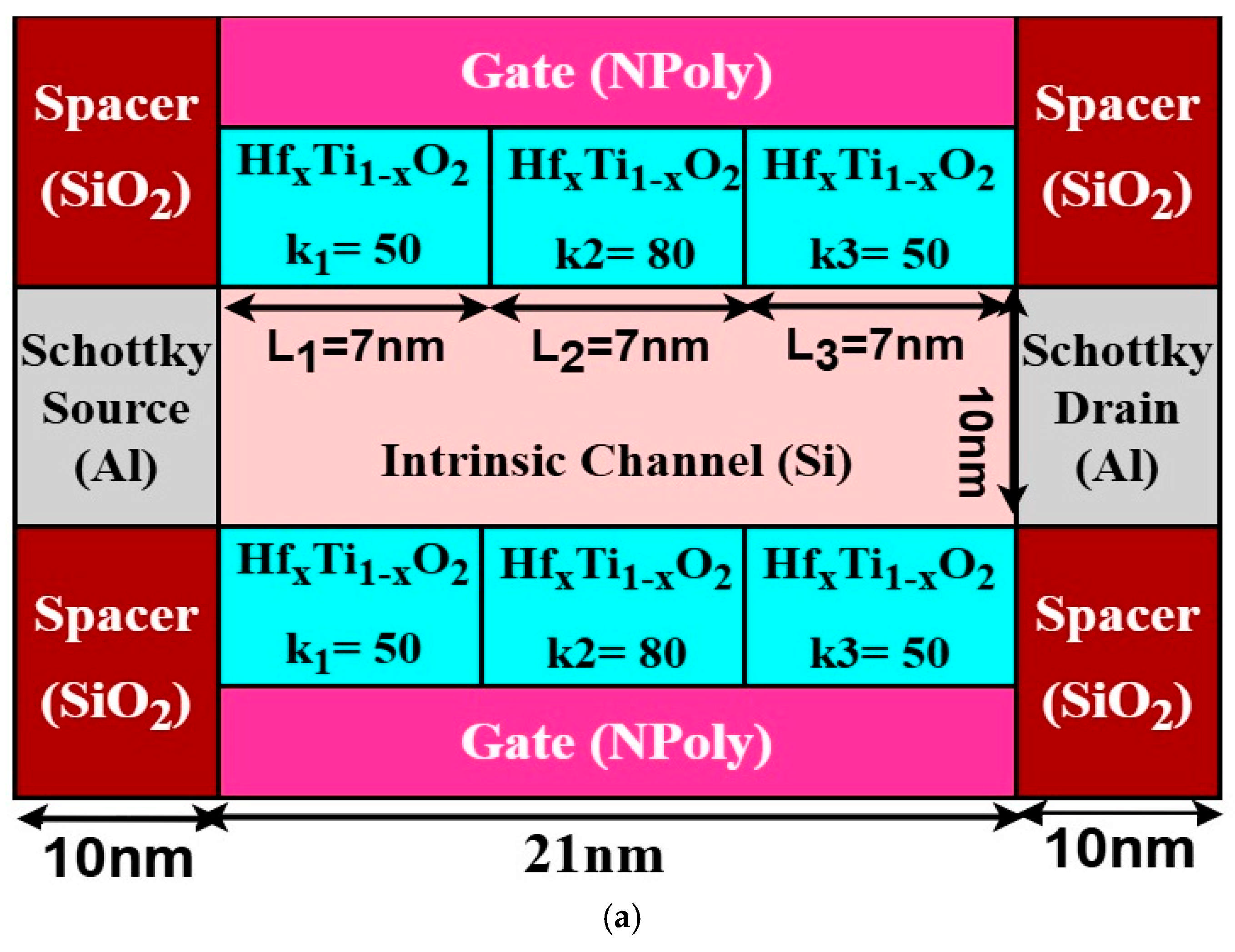


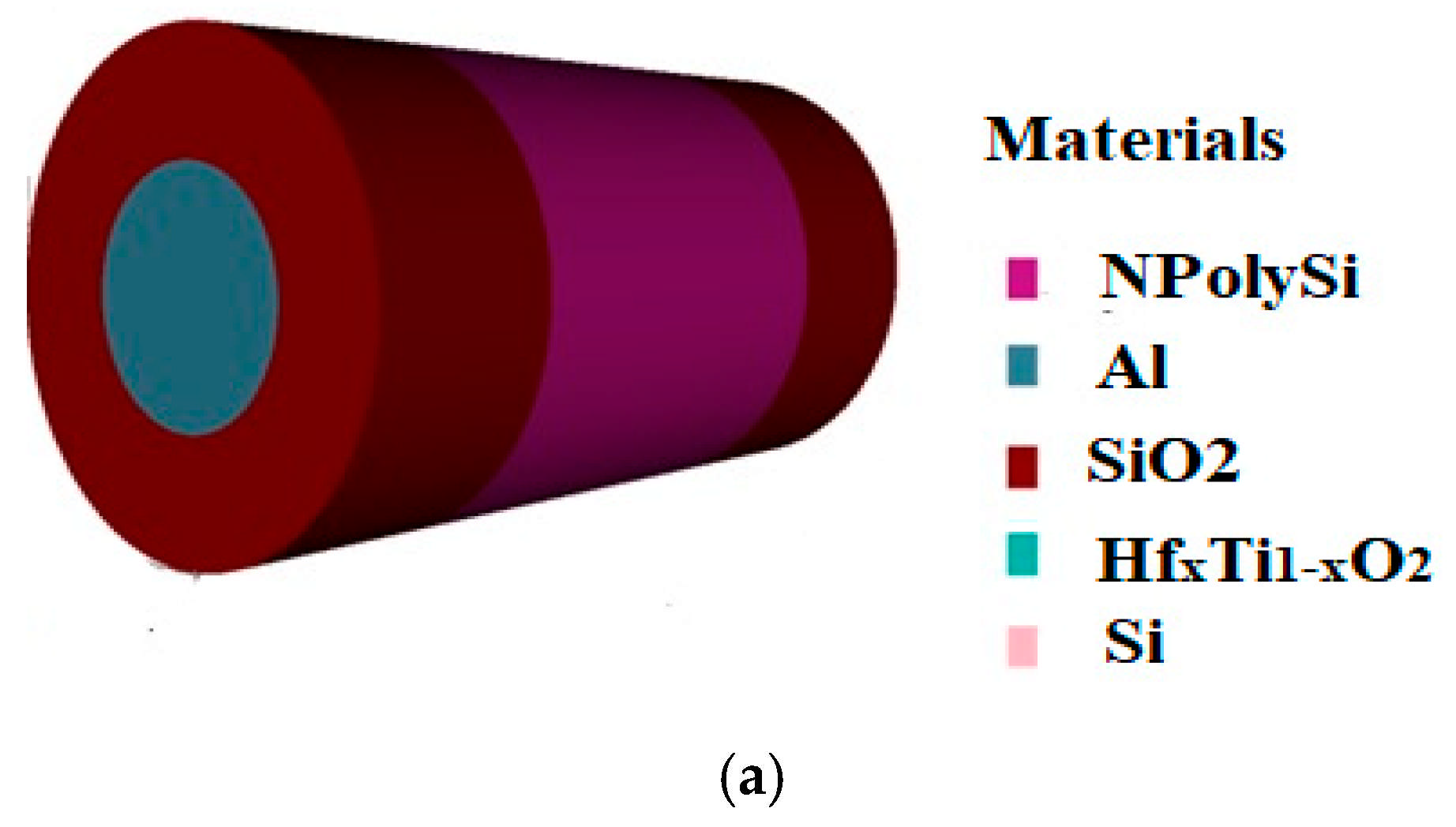
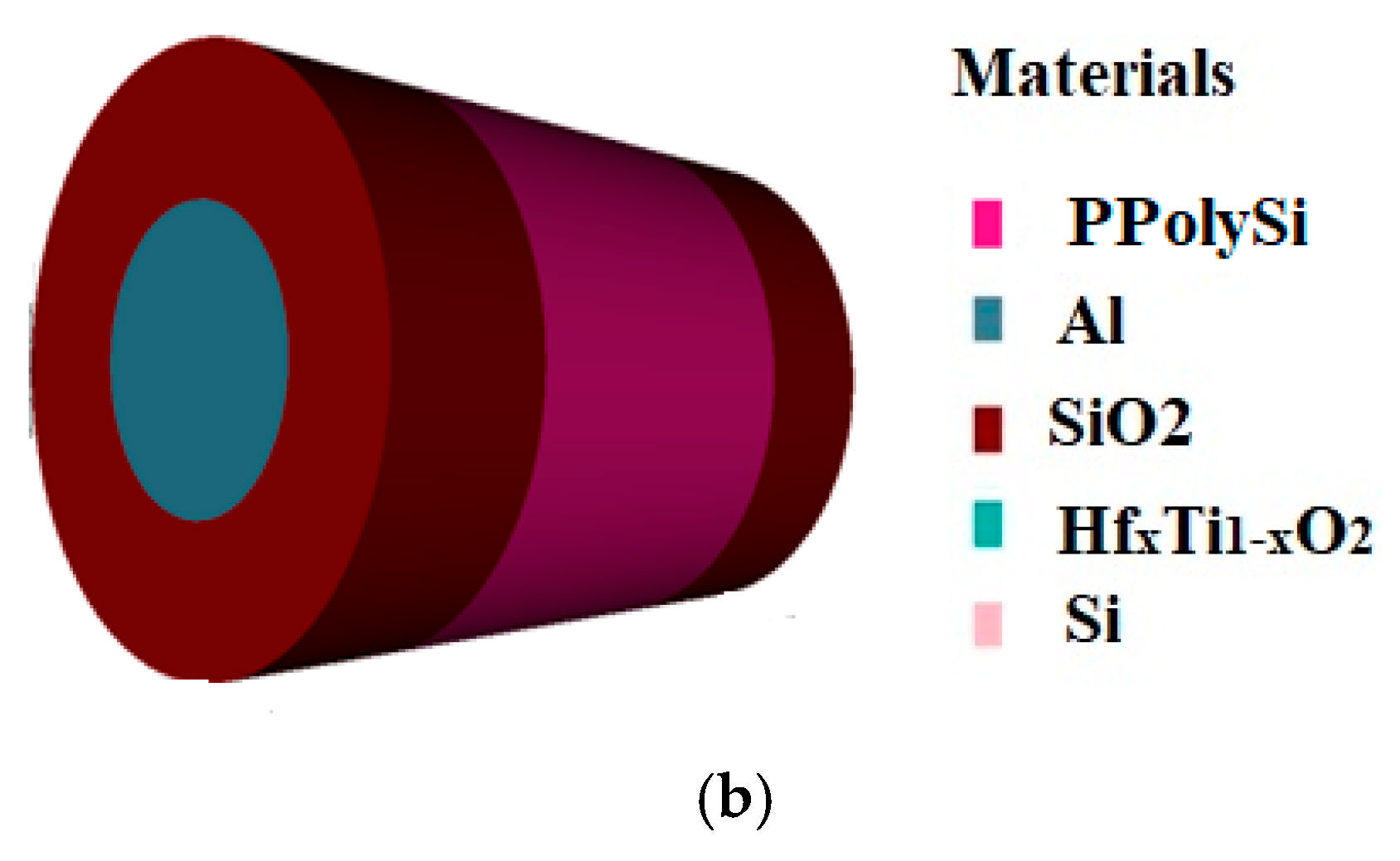




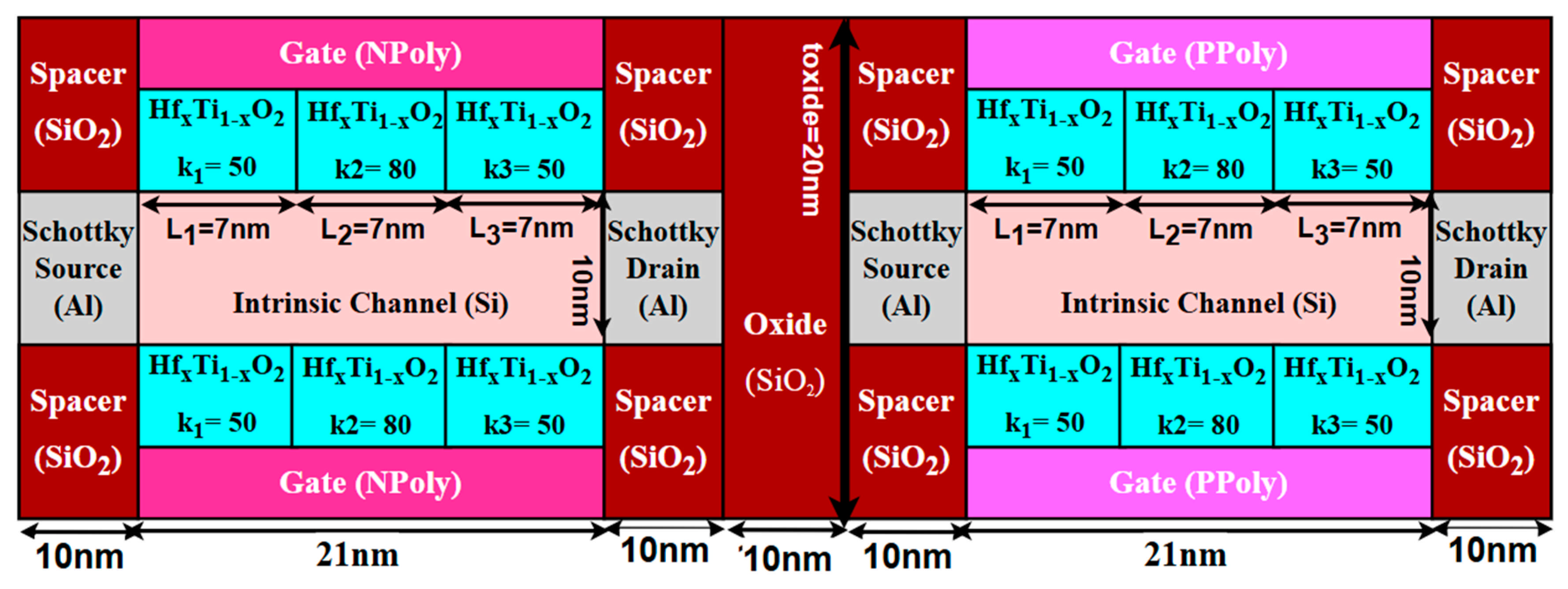
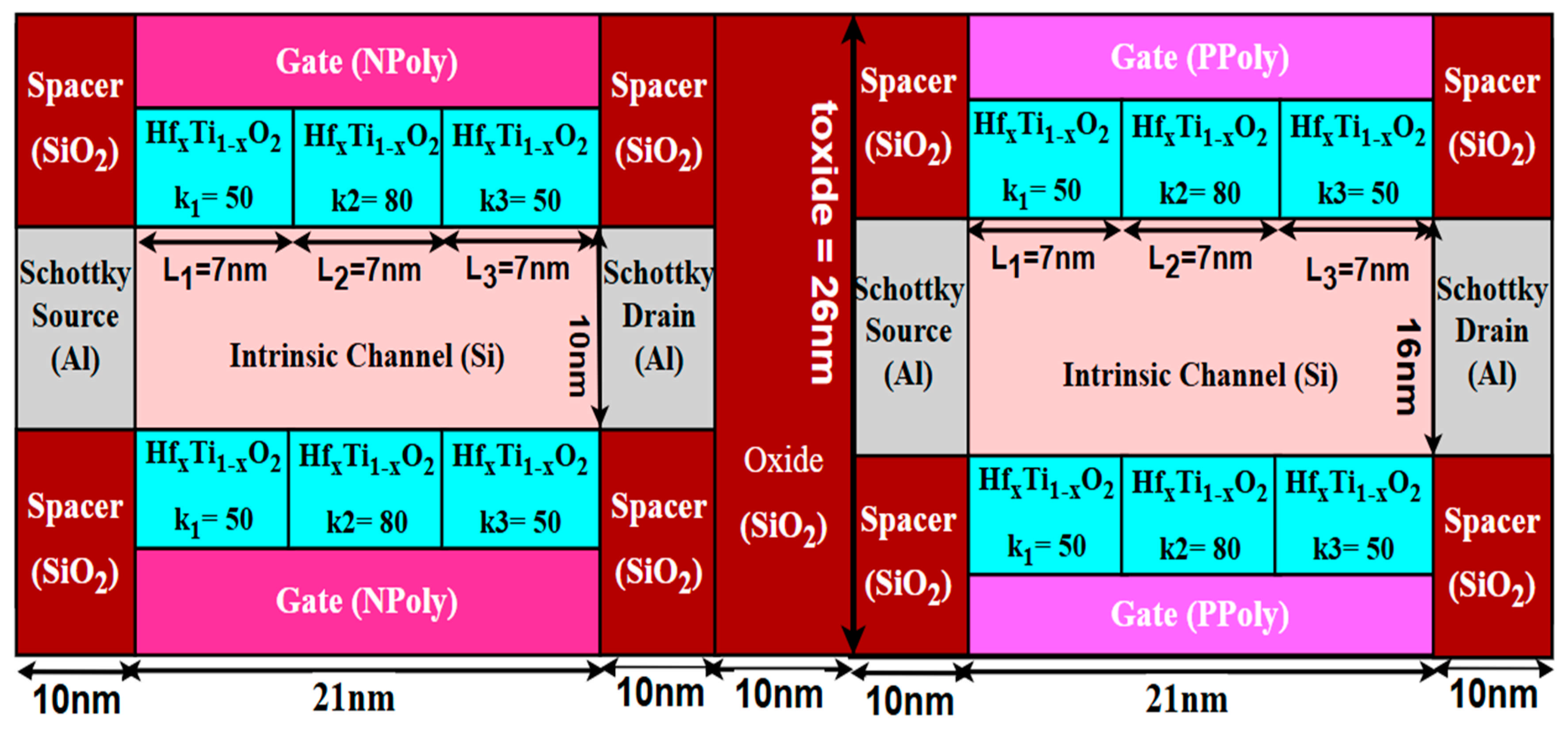


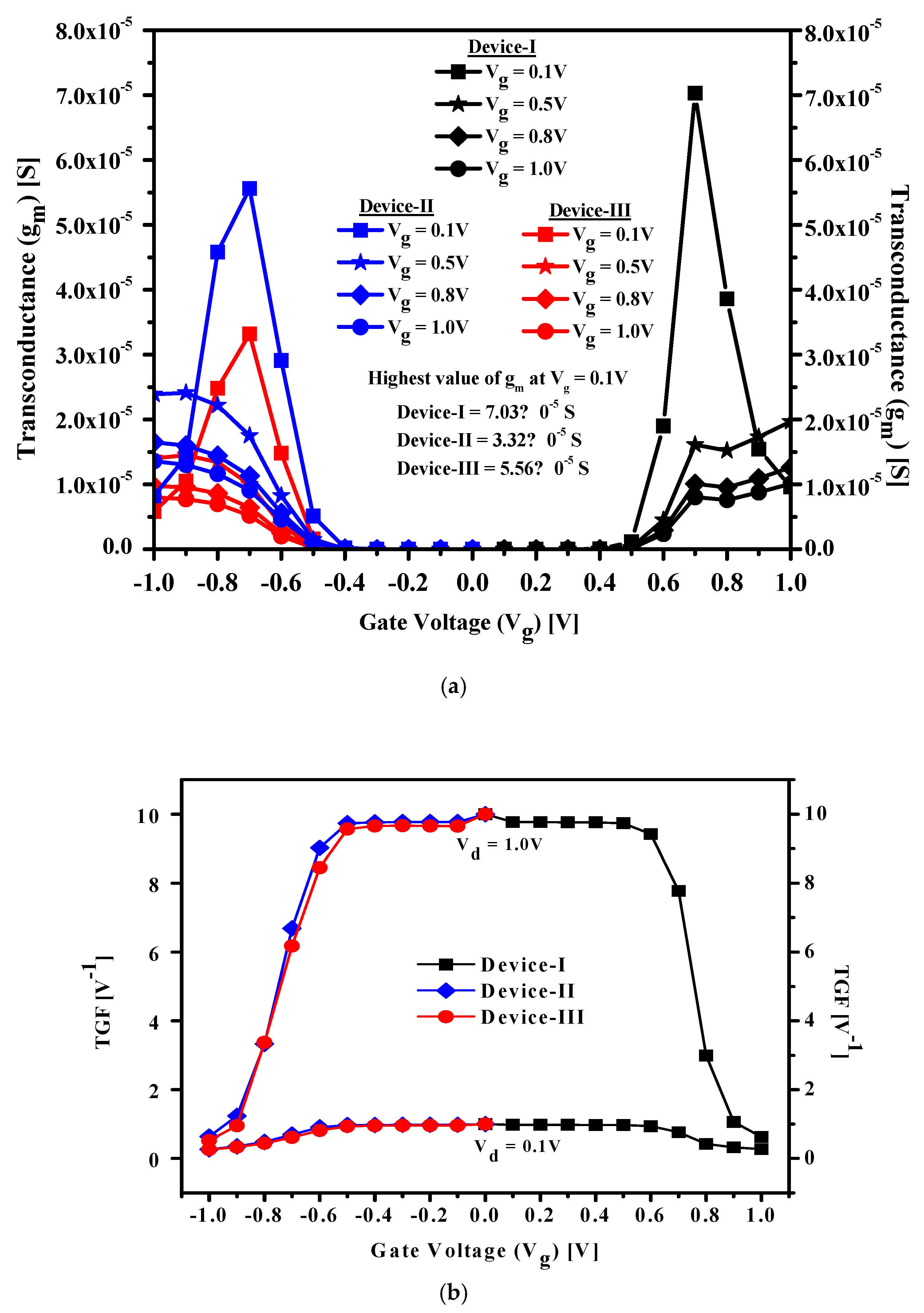
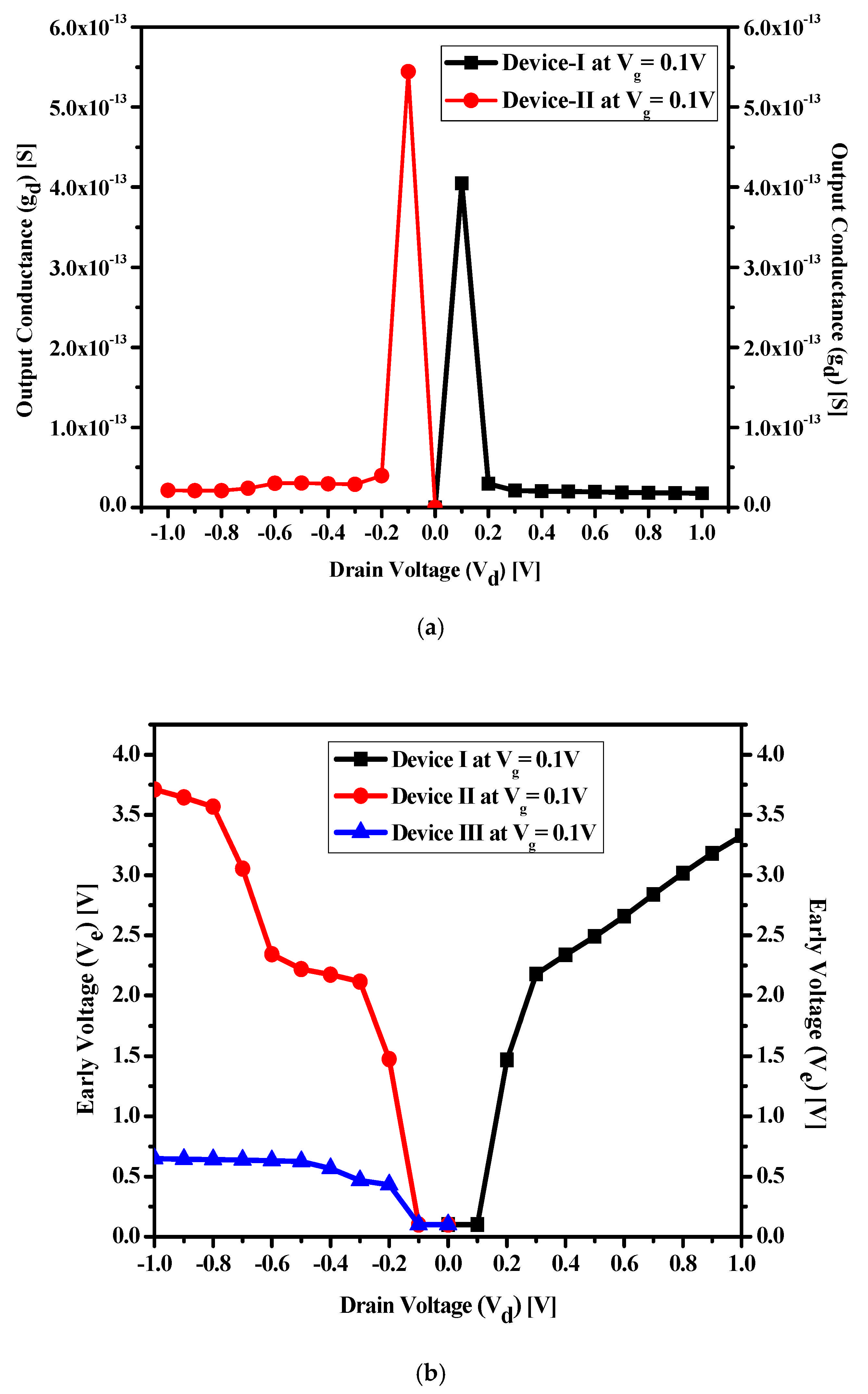
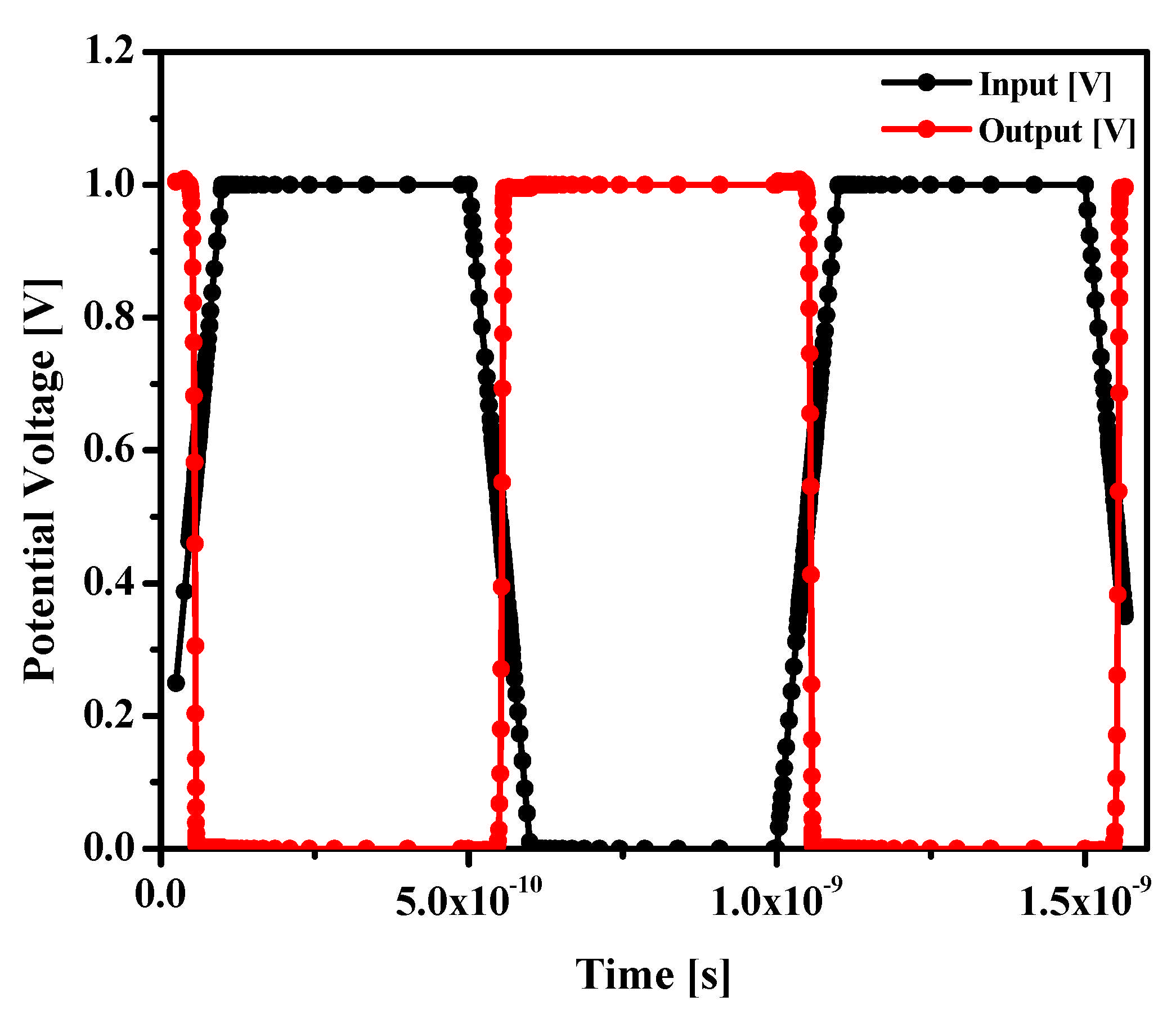
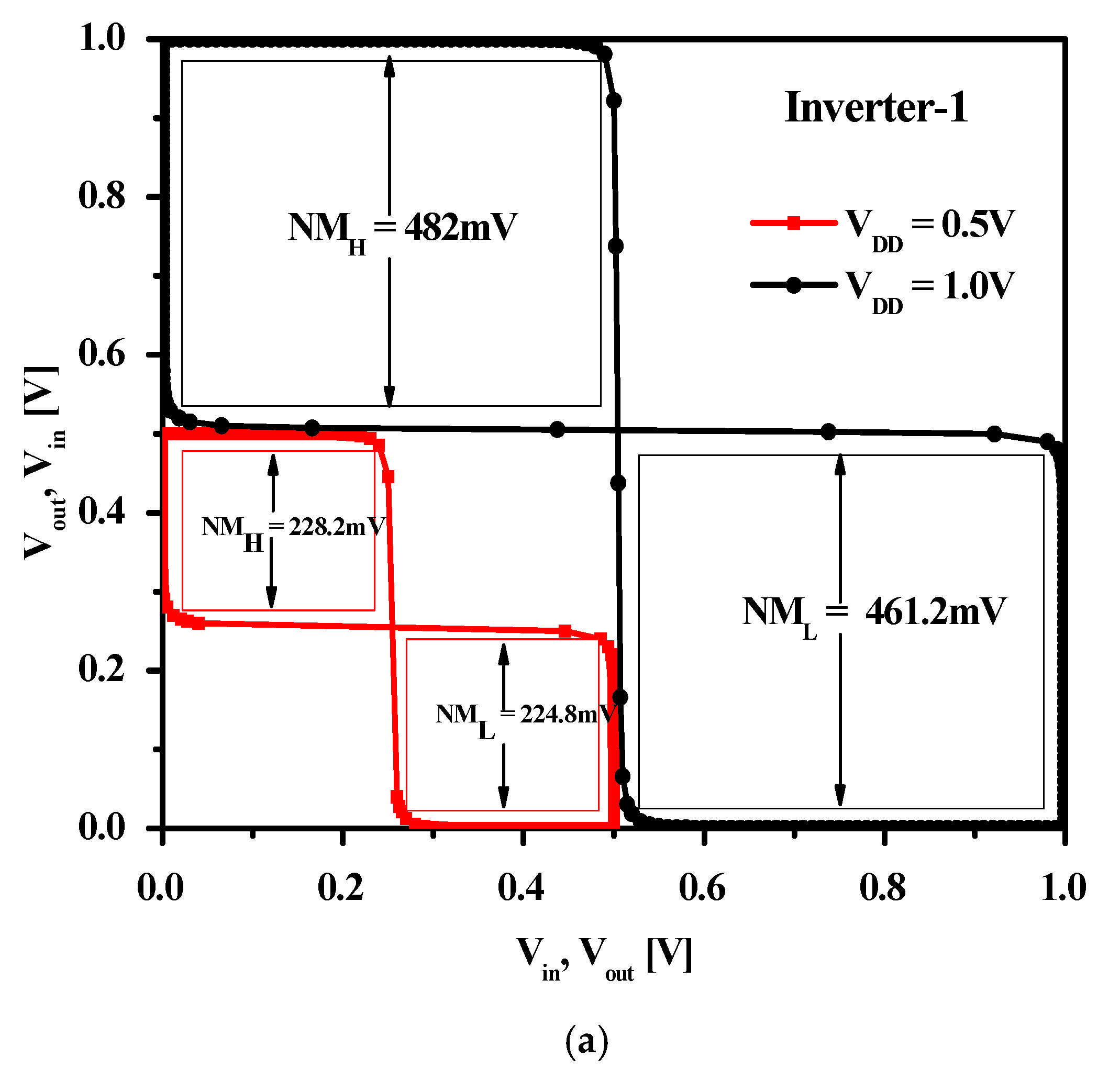

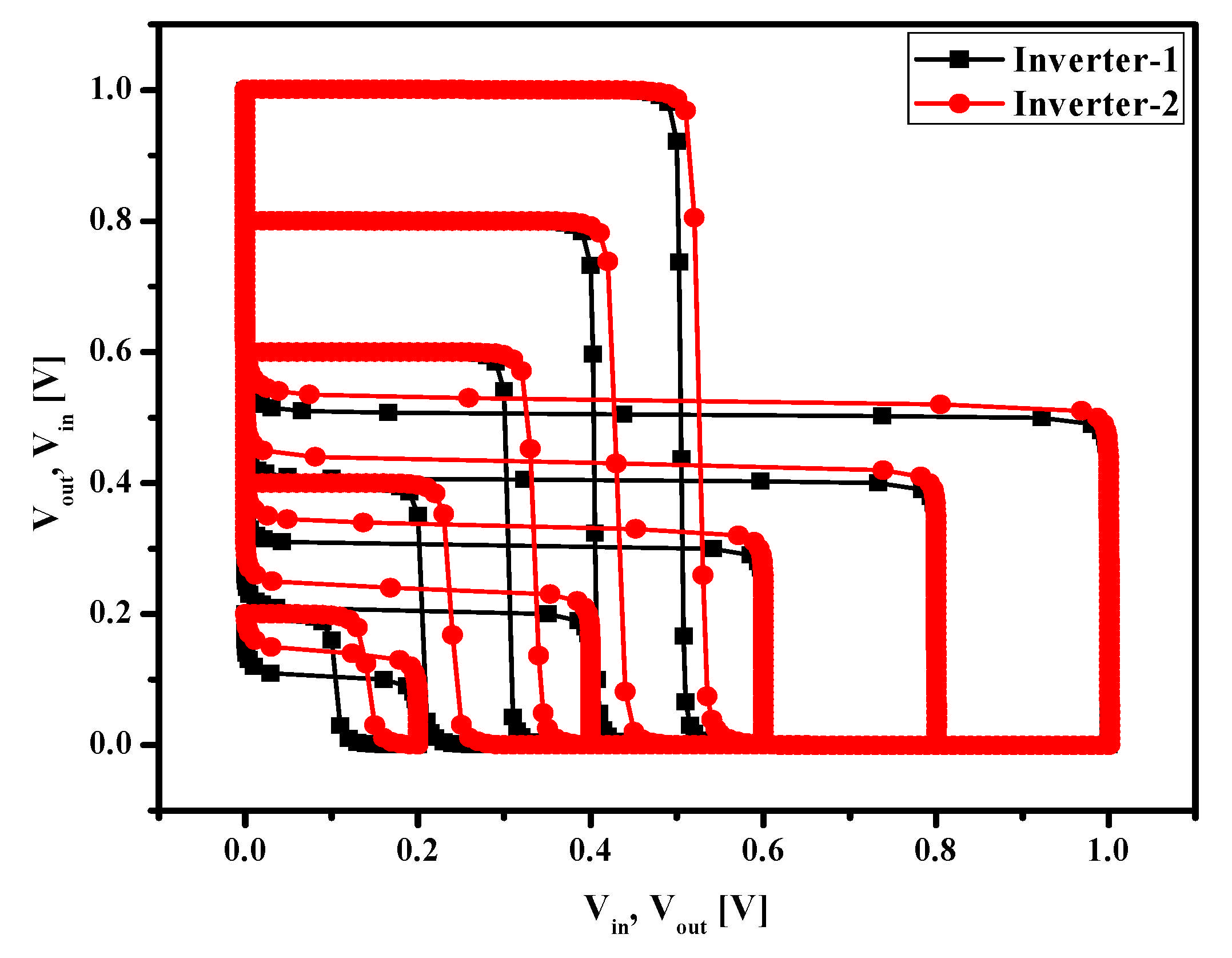
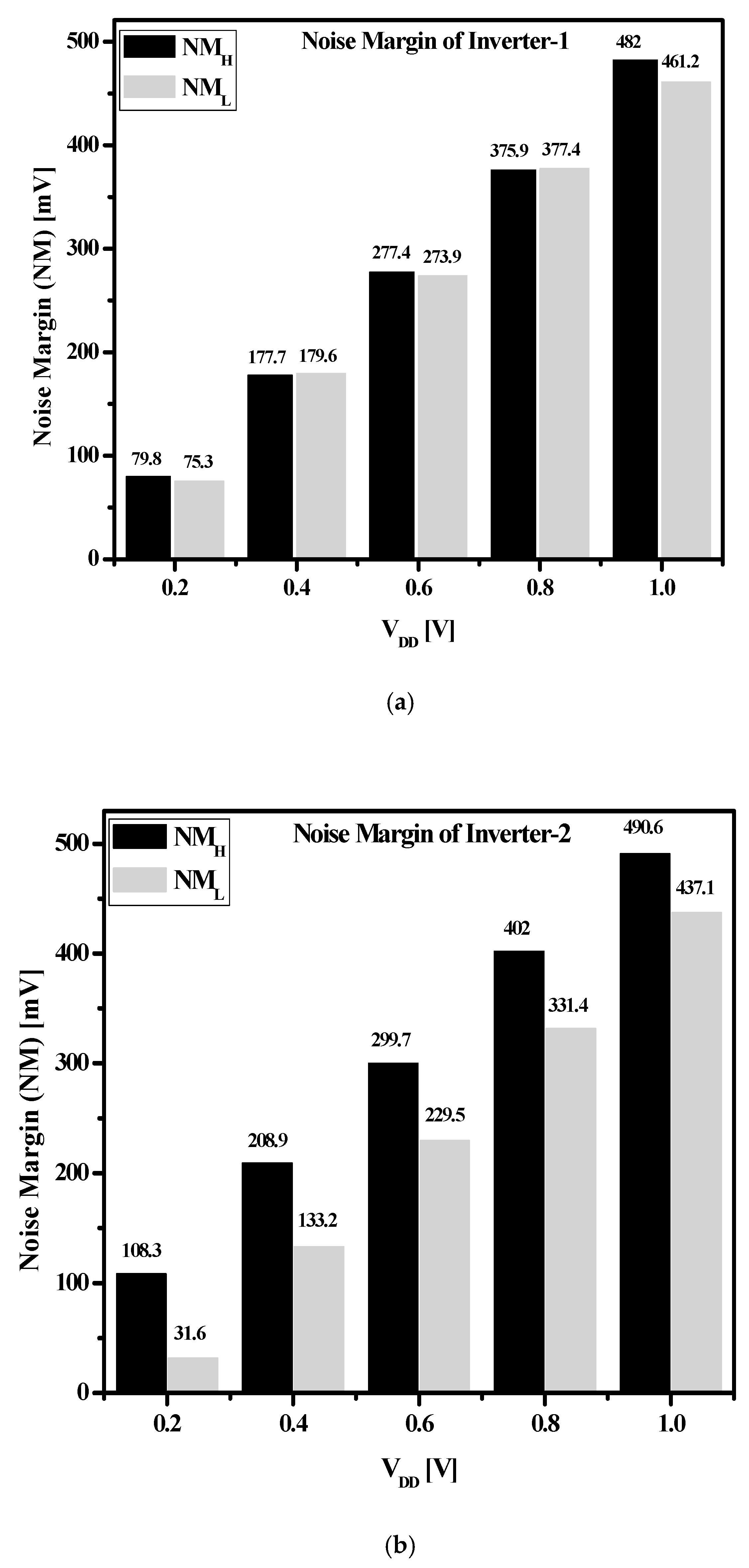
| Parameters | Device-I | Device-II and Device-III |
|---|---|---|
| Silicon-Body Radius (nm) | 5 | 5, 8 |
| Oxide Thickness (nm) | 2 | 2 |
| Length of Source/Drain (nm) | 10 | 10 |
| Si Channel Length (nm) | 21 | 21 |
| Doping Concentration of Channel (cm−3) | 1 × 1016 | 1 × 1016 |
| Gate Work Function (eV) | 4.8 | 4.67 |
| Work Function of Source/Drain (eV) | 4.2 | 5.3 |
| Dielectric Constant of Gate Oxide (k) | HfxTi1−xO2 (k1 = 50, k2 = 80, k3 = 50) | HfxTi1−xO2 (k1 = 50, k2 = 80, k3 = 50) |
| Parameters | Inverter-1 | Inverter-2 |
|---|---|---|
| Device Radius (nm) | 5 (Device-I), 5 (Device-II) | 5 (Device-I), 8 (Device-III) |
| Oxide Thickness (nm) | 2 | 2 |
| Length of Source/Drain (nm) | 10 | 10 |
| Si Channel Length (nm) | 21 | 21 |
| Work Function of Gate (eV) | 4.8 (Device-I), 4.67 (Device-II) | 4.8 (Device-I), 4.67 (Device-III) |
| Work Function of Source/Drain (eV) | 4.2 (Device-I), 5.3 (Device-II) | 4.2 (Device-I), 5.3 (Device-III) |
| Length of Spacer (nm) | 10 | 13 |
| High-k Value (k) | k1 = 50, k2 = 80, k3 = 50 | k1 = 50, k2 = 80, k3 = 50 |
| Parameters | Device-I (Radius—5 nm) | Device-II (Radius—5 nm) | Device-III (Radius—8 nm) |
|---|---|---|---|
| ION (A) | 1.54 × 10−5 | 9.07 × 10−6 | 1.58 × 10−5 |
| IOFF (A) | 0.94 × 10−15 | 1.26 × 10−15 | 3.27 × 10−14 |
| ION/IOFF | 1.63 × 1010 | 7.20 × 109 | 4.82 × 108 |
| SS (mV/dec) | 61.8 | 61.4 | 68.2 |
| DIBL (mV/V) | 8.2 | 8 | 39 |
| Parameters | Device-I | Device-II | Device-III |
|---|---|---|---|
| gm (S) | 7.03 × 10−5 | 3.32 × 10−5 | 5.55 × 10−5 |
| gd (S) | 1.77 × 10−14 | 2.13 × 10−14 | 8.15 × 10−12 |
| Ve (V) | 3.342331 | 3.71027 | 0.64657 |
| TGF (V−1) | 10 | 10 | 10 |
| Devices | Device Dimensions | Proposed Devices (k1 = 50, k2 = 80, k3 = 50) HD-SM-GAA MOSFET | Existing Literature (k = 50) (Kaur et al., 2019) HD-SM-SB-GAA NWFET [24] | % Age Improvement |
|---|---|---|---|---|
| Device-I | SS (mV/dec) | 61.8 | 63.88 | 3.25% |
| DIBL (mV/V) | 8.2 | 21.28 | 61.46% | |
| ION/IOFF | 1.63 × 1010 | 7.10 × 109 | 2.29 times | |
| Device-II | SS (mV/dec) | 61.4 | 64.06 | 4.15% |
| DIBL (mV/V) | 8 | 25.72 | 68.89% | |
| ION/IOFF | 7.20 × 109 | 2.8 × 109 | 2.57 times |
| Devices | Device Dimensions | Proposed Devices HD-SM-GAA MOSFET Radius = 5 nm (Diameter = 10 nm), Vd = 0.1 V, Gate dielectric, HfxTi1−xO2 (k1 = 50, k2 = 80, k3 = 50) of 21 nm Channel Length | Existing Literature Diameter 11 nm, Vd = 0.8 V (Nayak et al., 2014), Gate Dielectric, k = 3.9 (SiO2) of 17 nm Channel Length [37] | % Age Improvement |
|---|---|---|---|---|
| Device-I | SS (mV/dec) | 61.8 | 67.5 | 8.44% |
| DIBL (mV/V) | 8.2 | 50 | 83.60% | |
| ION/IOFF | 1.63 × 1010 | 8.25 × 106 | 1.97 × 103 times | |
| gm(µS) | 70.3 | 52.9 | 32.89% | |
| Device-II | SS (mV/dec) | 61.4 | 73 | 15.89% |
| DIBL (mV/V) | 8 | 66 | 87.87% | |
| ION/IOFF | 7.20 × 109 | 8.57 × 106 | 0.84 × 103 times | |
| gm (µS) | 33.2 | 63.07 | 47.36% |
| Present Work | Parameters NMH and NML (mV) at VDD = 1.0 V | Existing Work (Nayak et al., 2014), Diameter = 11 nm, Channel Length = 17 nm, Vd = 1 V, Gate Dielectric, k = 3.9 (SiO2) NMH = 350 mV, NML = 320 mV % Age Improvement [37] |
|---|---|---|
| Inverter-1 (Device-I and Device-II) | NMH = 482 mV | 38% (Increased) |
| NML = 461.2 mV | 44% (Improved) | |
| Inverter-2 (Device-I and Device-III) | NMH = 490.6 mV | 40% (Enhanced) |
| NML = 437.1 mV | 37% (Increased) |
Disclaimer/Publisher’s Note: The statements, opinions and data contained in all publications are solely those of the individual author(s) and contributor(s) and not of MDPI and/or the editor(s). MDPI and/or the editor(s) disclaim responsibility for any injury to people or property resulting from any ideas, methods, instructions or products referred to in the content. |
© 2025 by the authors. Licensee MDPI, Basel, Switzerland. This article is an open access article distributed under the terms and conditions of the Creative Commons Attribution (CC BY) license (https://creativecommons.org/licenses/by/4.0/).
Share and Cite
Devi, R.; Kaur, G.; Seehra, A.; Rattan, M.; Aggarwal, G.; Short, M. Low-Power Energy-Efficient Hetero-Dielectric Gate-All-Around MOSFETs: Enablers for Sustainable Smart City Technology. Energies 2025, 18, 1422. https://doi.org/10.3390/en18061422
Devi R, Kaur G, Seehra A, Rattan M, Aggarwal G, Short M. Low-Power Energy-Efficient Hetero-Dielectric Gate-All-Around MOSFETs: Enablers for Sustainable Smart City Technology. Energies. 2025; 18(6):1422. https://doi.org/10.3390/en18061422
Chicago/Turabian StyleDevi, Ram, Gurpurneet Kaur, Ameeta Seehra, Munish Rattan, Geetika Aggarwal, and Michael Short. 2025. "Low-Power Energy-Efficient Hetero-Dielectric Gate-All-Around MOSFETs: Enablers for Sustainable Smart City Technology" Energies 18, no. 6: 1422. https://doi.org/10.3390/en18061422
APA StyleDevi, R., Kaur, G., Seehra, A., Rattan, M., Aggarwal, G., & Short, M. (2025). Low-Power Energy-Efficient Hetero-Dielectric Gate-All-Around MOSFETs: Enablers for Sustainable Smart City Technology. Energies, 18(6), 1422. https://doi.org/10.3390/en18061422








